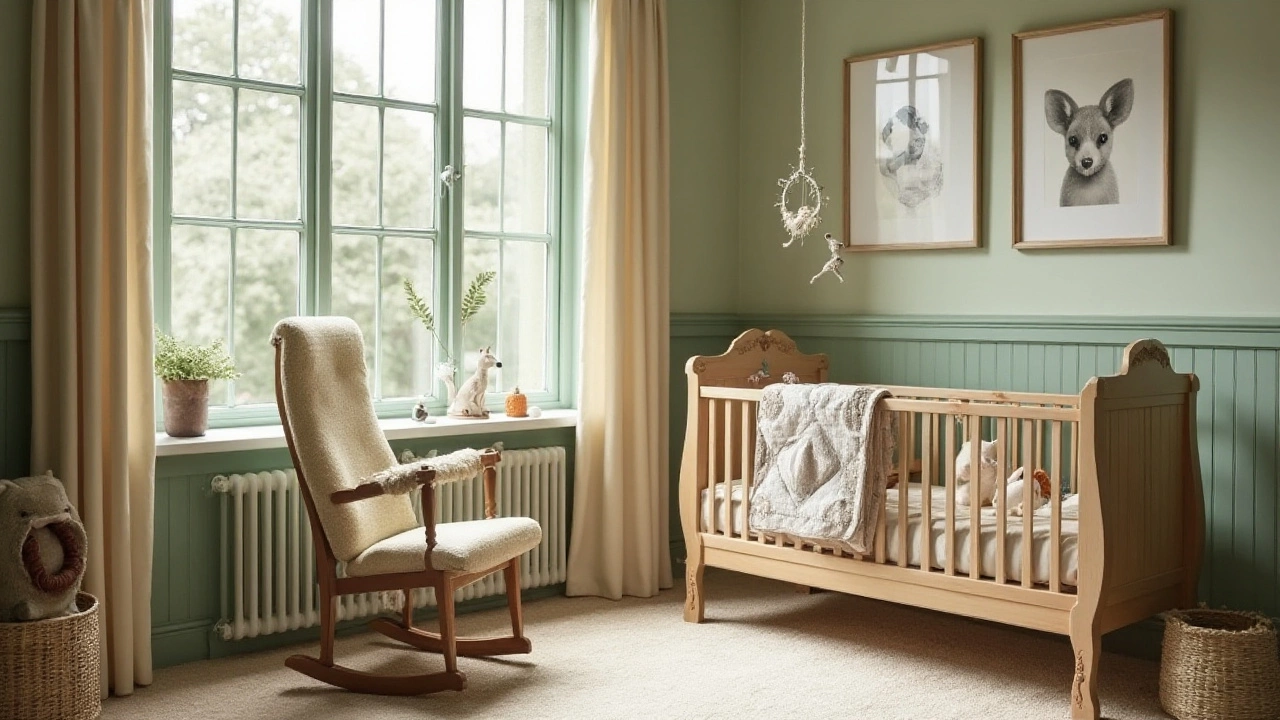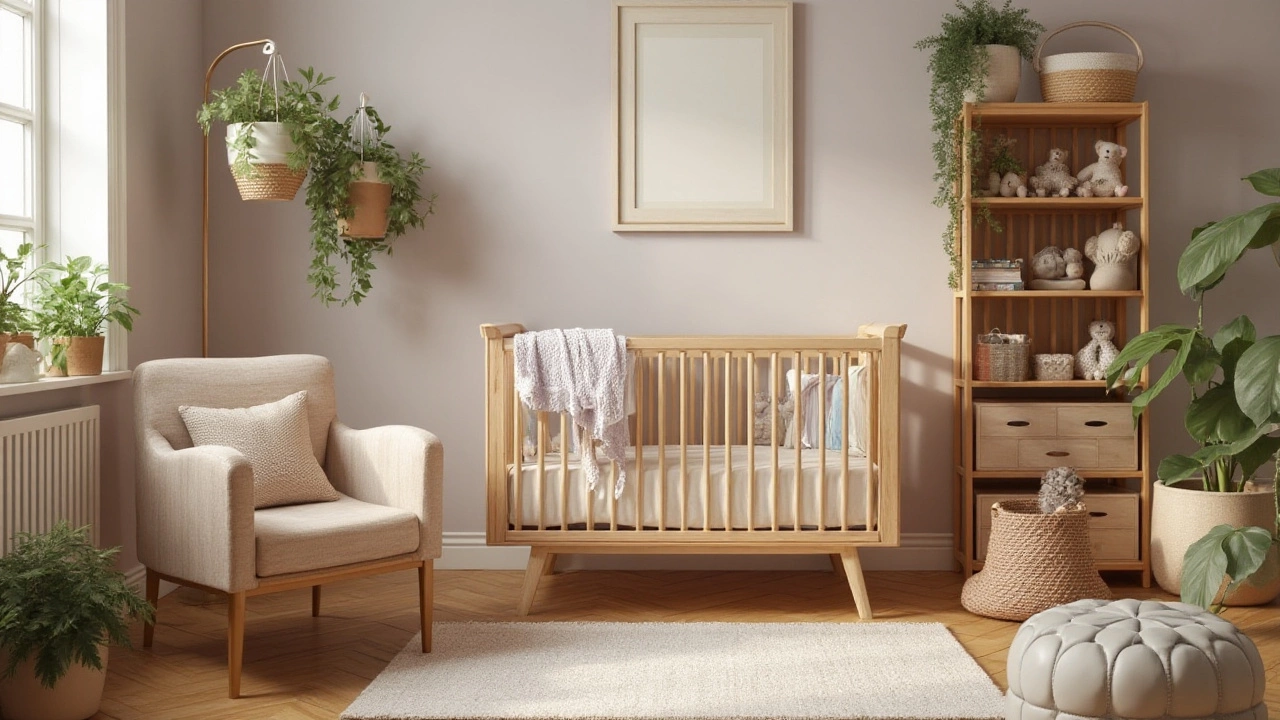
When setting up a nursery, one of the most important aspects is ensuring it's a warm and comforting space for your little one. A cozy environment not only helps in creating a soothing atmosphere for the baby but also provides a relaxing space for parents. Achieving the right level of warmth doesn’t require extravagant measures; it’s about choosing the right elements that harmonize comfort and style.
From the calming hues on the walls to the snuggly textiles and soft lighting, every detail plays a part in creating a nurturing nursery. Beyond aesthetics, consider the practicalities of a nursery that adapts as your child grows. Whether you're starting from scratch or looking to spruce up an existing setup, these insights will help you craft a space that's both beautiful and functional.
- Choosing the Right Color Scheme
- Furniture Placement and Selection
- Accessories and Textiles for Warmth
- Lighting to Enhance Comfort
- Personal Touches and Decor Ideas
Choosing the Right Color Scheme
Selecting the ideal color scheme for your nursery warmth sets the tone for the room. The choice of colors impacts both the mood of the space and its aesthetic cohesion, making it crucial to pick hues that align with your vision. Many parents gravitate towards soft, neutral tones—think creamy whites, gentle grays, and pastel shades. These colors lend a soothing quality that's perfect for a nursery, offering a sense of peace and serenity. Besides their calming effect, neutrals act as the perfect backdrop for other design elements, allowing colorful accessories or patterns to stand out without overwhelming the room.
One effective approach is to employ a mix of warm and cool tones for a balanced atmosphere. Warm colors such as soft yellows, blush pinks, or light oranges can evoke feelings of coziness and intimacy. On the other hand, cooler shades like pale blues or mint greens can produce a tranquil environment, promoting relaxation. When combined thoughtfully, these tones can transform a nursery into a sanctuary of warmth. It's also beneficial to consider the natural light available in the room, as it can significantly alter the perception of the colors you choose. In rooms with abundant natural light, you might lean towards cooler tones, whereas darker spaces can benefit from brighter, warm hues to prevent a gloomy feel.
Incorporating Accents and Patterns
Adding accent walls or patterns can give the nursery a unique touch while maintaining balance within your color scheme. Wallpaper featuring gentle motifs or nature-inspired murals can add whimsy and character. Stripes or polka dots in complementary colors can break the monotony, adding depth without being too domineering. As parents, it’s heartwarming to know that these details not only enhance the room's appeal but can also stimulate your baby’s senses as they grow. Experts often suggest ensuring that bold elements are balanced with softer items to avoid overstimulation. For instance, pairing a striking pattern with a simple crib design can keep the room aesthetically pleasing without becoming chaotic.
"Color is a power which directly influences the soul," said the renowned artist Wassily Kandinsky. His wisdom applies aptly to nursery design, where the right colors can subtly shape both infant and parental experiences.
If you're undecided, creating a mood board can help visualize how potential colors and patterns work together. This process aids in refining your choices and ensures consistency throughout the design plan. Just remember that the nursery should ultimately reflect warmth and comfort, serving as a nurturing space for bonding and growth. With the right color choices, you can create a cherished sanctuary filled with cozy nursery tips that will make both you and your baby feel right at home.
Furniture Placement and Selection
Designing a nursery isn’t just about choosing pretty furniture; it’s about creating a sanctuary where both parents and baby can feel at ease. When selecting and arranging nursery furniture, it’s essential to prioritize functionality and safety while aiming for warmth. Begin by considering the room's layout, taking into account the position of windows, doors, and any existing architectural features that might influence your design. This will help you in strategically placing larger pieces such as the crib and changing table, ensuring that they don’t obstruct access and that you can move comfortably within the space.
A significant aspect is the placement of the crib. Position it away from windows to avoid drafts and out of direct sunlight to prevent overheating. It’s also advisable to keep it a good distance from radiators. You want your baby’s sleeping area to be serene and safe, allowing the small room to breathe without clutter. The changing table is another fundamental piece that should be within arm's reach of both the crib and storage units for diapers and other supplies. This makes changing time efficient and stress-free.
Choosing multifunctional furniture is another way to maximize warmth and utility. Dressers that double as changing tables or cribs with built-in storage can save space and reduce the need for additional furniture that can overwhelm the room. Opting for items with rounded edges and non-toxic finishes adds an extra layer of safety without compromising on warmth. A quote from interior designer Emily Henderson highlights the importance of selecting the right pieces:
“In a nursery, every piece of furniture should serve more than one function. It's about working smart with your available space while ensuring comfort for both mom and baby.”
Creating a cozy nursery also involves thinking about the materials. Wooden furniture with soft, warm tones can add a touch of comfort compared to metal or stark white pieces. Upholstered nursery gliders or rocking chairs can provide a cozy touch, encouraging bonding moments between parent and baby. It’s the blend of these pieces that weaves a harmonious, inviting atmosphere.
To further emphasize the strategic use of space, consider implementing a layout where each functional area, such as sleeping, changing, and feeding, is clearly defined yet seamlessly connected. Balance is key, and it can be achieved by combining necessity with decorative elements, ensuring that the essence of warmth remains at the forefront in creating that perfect cozy nursery warmth environment.

Accessories and Textiles for Warmth
When it comes to creating a sense of warmth in a nursery, the choice of accessories and textiles can make a dramatic difference. From the curtains that gently sway with the breeze to the rugs that cushion little feet, every textile element contributes to the cozy vibe. Incorporating soft, textured fabrics like cotton, wool, and fleece can elevate the space, making it feel inviting and snug. A simple way to add immediate warmth is through layering: layering soft blankets over a crib or gently draped across a rocking chair offers both aesthetic appeal and practical comfort. Look for materials that are easy to clean, given that babies can be quite unpredictable. Consider hypoallergenic materials, which add a layer of safety for your child, reducing the risk of irritations or allergies.
In choosing curtains or blinds, consider light-filtering options that allow in natural light while maintaining privacy. Natural sunlight is not only warming but also helps regulate the baby’s sleep cycle. A pro tip is using a dual-layer approach with blackout blinds underneath sheer curtains; this way, you can control the lighting according to the baby's needs. Rugs are another wonderful addition to a nursery. They not only provide a cushy surface on the floor but also help with sound absorption, creating a quieter environment—a boon for nap times. Opt for plush, washable rugs in complementary colors to the room’s palette, ensuring they are skid-proof to avoid accidents.
"Textiles in a nursery don't just enhance the look—they impact the overall feel and functionality of the room," noted Jane Collins, an interior designer with over 20 years of experience in crafting child-friendly spaces.
Adding personalized touches can also warm the space. This could mean monogrammed blankets or cushions bearing the baby's name or initials, bringing a sense of unique identity to the room. Don’t overlook the power of soft toys and plush animals, which serve dual purposes as decor and playtime companions. Wall hangings crafted from fabrics such as felt or quilted wall panels can add dimension and texture to the nursery walls, making the space feel more dynamic and engaging for a child's developing senses.
If achieving warmth through textiles seems daunting, consider starting with a color scheme that complements your fabric choices. Often, warm earth tones such as terracotta or soft yellows can serve as wonderful backdrops for accessories, easily enhanced with deeper hues in soft furnishings. Incorporating textiles with patterns or gentle motifs can add something special to the decor. Remember, the aim is to build a sanctuary that is calm and conducive to rest, filled with tactile comforts that reassure both parent and child alike.
Lighting to Enhance Comfort
Lighting plays a crucial role in how a room feels, and this is especially true in a nursery. The right lighting can create a tranquil space conducive to relaxation, sleep, and play. To enhance comfort in your baby's nursery, it's wise to consider layers of lighting. This approach allows you to adjust the intensity and focus of light according to the time of day and needs. At the forefront of this strategy should be a soft ambient light that serves as the primary source, paired with accent and task lighting for balance and functionality.
A gentle ambient light can be achieved through a ceiling fixture like a decorative pendant or a flush mount light. These should ideally come with a dimmer switch, allowing you to control brightness levels and create a soothing atmosphere as needed, especially during nighttime feedings or nap times. Choosing a light fixture that incorporates a warm soft white bulb is essential. Research from lighting experts highlights that bulbs with a color temperature between 2700K and 3000K are ideal for creating a cozy ambiance reminiscent of sunlight, reducing sleep disruptions caused by harsher, cooler lights.
Accent lighting, such as table lamps or nightlights, provides additional warmth and visual interest. Strategic placement around the nursery can highlight specific areas, perhaps illuminating a memorable piece of nursery furniture or a charming artwork on the wall. These lights serve more than just a decorative purpose; they offer flexibility when the main light is too much. It's wise to select fixtures that aren't showcasing visible bulbs, as direct light can be too harsh. For a whimsical touch, consider string lights or light projectors that cast gentle shapes across the walls and ceiling, making the nursery a wonderland of gentle stars or soothing patterns.
"The ability to adjust lighting, to modulate brightness and even hue, can have significant effects on the comfort level for both baby and parents," suggests Lydia Martinez, a renowned interior designer specializing in nurseries.Task lighting is especially useful near changing tables, reading nooks, or within reach of seating areas where you might feed or cuddle your baby. A focused lamp here provides plenty of light where needed but doesn't overwhelm the room. Look for lamps with adjustable heads or arms, so light can be directed and redirected as necessary. This kind of flexibility is invaluable as your nursery evolves and becomes a multipurpose room filled with young life.
Modern technology offers additional comforting lighting solutions, like motion-sensitive lights that gently illuminate only when needed, such as during late-night trips for diaper changes. More advanced options come with smart lighting systems that can be managed from your phone, letting you change settings without disturbing your baby. Such advancements provide convenience and utility, allowing parents to create the ideal nursery environment with the touch of a screen. A mix of these lighting options ensures your nursery remains practical, engaging, and warm—key aspects of creating a cozy nursery.
When planning your nursery lighting, envision how different scenarios will unfold—from bedtime stories in a comfy chair to midnight soothing sessions. Embrace a variety of light sources that can work independently or together, cultivating an atmosphere that's as versatile as it is imbued with warmth. By blending different types of lighting, you are not just illuminating a room; you are crafting moods, encouraging restfulness, and showcasing cherished features of your nursery design.

Personal Touches and Decor Ideas
Adding personal touches to your baby's nursery is like dotting the 'i's and crossing the 't's; with these elements, you infuse the room with personality and warmth that standard furniture arrangements can't achieve. One simple yet profound method is incorporating family photos into the decor. A collection of framed family portraits not only adds emotional warmth but connects your baby with the faces that will become familiar and comforting. Consider creating a gallery wall with various frame styles and sizes to add visual interest and depth to one section of the wall. This approach also offers an excellent conversation starter, allowing you to tell stories as your child grows, who each person is, and their significance.
Another impactful way to personalize the nursery involves custom artwork. Whether it's a canvas featuring your baby's name or a quote important to your family, artwork can cement the room's vibe. Many parents choose whimsical themes like jungles or outer space, but don't be afraid to think outside the box. For example, a quote painting that reads, ‘Dream Big’ in a playful font sets a tone of aspiration that influences the space. According to renowned designer Sophie Paterson, "A nursery is the first place where a child's dreams take flight, so make it inspiring." Use pieces that resonate with you personally and contribute to the welcoming atmosphere.
When considering materials, remember that textures are as essential as visual aesthetics in creating a cozy atmosphere. Look for opportunities to enrich tactile experiences through items like plush rugs, soft blankets, and varied fabric wall art. These layers of texture not only make the nursery more visually intriguing but can provide sensory experiences for your baby as they grow and explore their environment. A tactile approach to decor invites curiosity and offers comfort, as babies often associate softness with safety and warmth.
For color inspiration, think beyond baby blue or pastel pink. Modest pops of color can be introduced through throw pillows, a colorful mobile, or even an accent wall. Consider a soft sage green or a sunny yellow as alternatives to the traditional. Such tones promote calmness and happiness, setting a tranquil scene for naps and nighttime routines. Coupled with nursery warmth advice, be sure to mix these elements with the color palette you've chosen to maintain harmony across the design. Alternatively, you could experiment with self-adhesive wall decals, as they allow you to change themes easily as your child's preferences evolve.
Don't overlook the power of scents and music in shaping a nurturing environment. A gentle lullaby wafting through the room from a sweet music box or speaker can soothe your baby into a restful sleep. As for scents, consider using naturally calming fragrances like lavender in diffusers; these can improve the overall mood and relaxation within the nursery. Remember, it's the combination of all these loving details that transforms a room from a functional space into a beloved sanctuary filled with cozy nursery tips.


